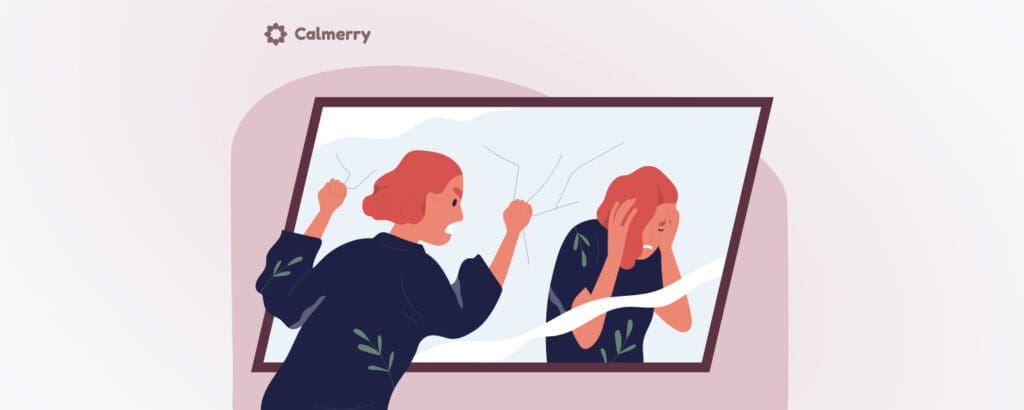How to Find Your Inner Child and Heal It
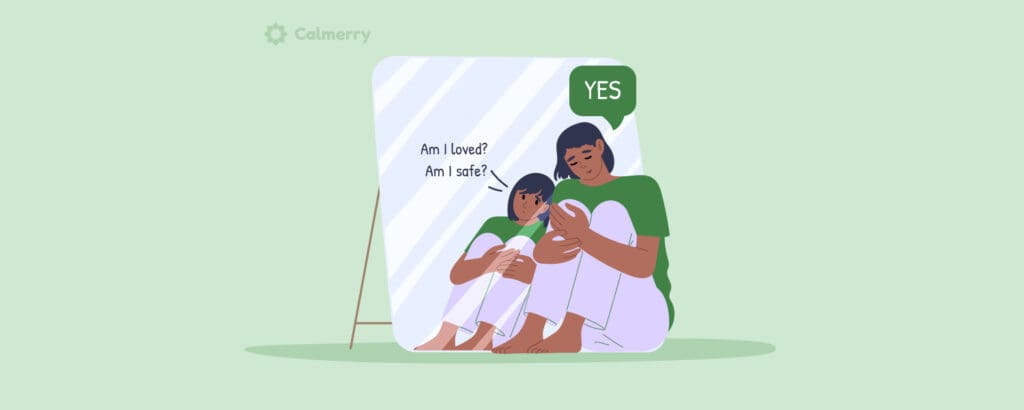
In this article
Inside every person is a child – playful, curious, creative, and perceptive but also sensitive, wounded, and suffering.
Our inner child is always there, whether we’re conscious of it or not. If we don’t learn to get in touch with it, we’ll miss out on a great joy in life as well as the opportunity to heal deep and powerful wounds.
When our needs aren’t met as children, we develop attachment wounds that impact our adult relationships and continue to nag at us into adulthood and old age. We often try to forget our inner child to protect ourselves from vulnerability, and in doing so, stuff our memories deep down.
While our inner child is seeking care and attention, we pretend it doesn’t exist because we’re afraid of facing the pain that it holds. We’ll watch Netflix, overeat, spend hours on social media, shop, gamble, drink alcohol, or do anything else to avoid the potential of experiencing painful emotions.
The problem is, the pain and suffering will still be there and will find a way to express themselves–whether we’re conscious of it or not. And when it’s hidden, it tends to come out in much more insidious ways.
Our inner child is not something to be afraid of or to push away, it’s something to explore, embrace, and care for.
Inner child: what is it?
All of your experiences from infancy to toddlerhood and youth become a part of you–even in ways that you can’t directly perceive. Psychoanalyst Carl Jung described the divine child as being a collective part of the human experience.
The inner child is a source of great strength and wisdom. As children, we observe the world around us and absorb teachings from our caretakers, teachers, and communities.
Many of us also carry deep wounds from childhood that if unaddressed, can cause maladaptive behavior and great suffering. These might arise from childhood trauma, emotionally unavailable caretakers, or not having your needs and feelings acknowledged or addressed.
The good news is that in adulthood, no matter what’s happened in your past, it’s possible to tap into the joy and wisdom of your inner child, heal your deep wounds, and thrive.
Signs your inner child needs healing
Most people have some amount of pain to process that stems from their childhood experiences. However, it can range from mild to severe.
Signs to look out for include:
Being emotionally volatile
You might go from 0 to 100, experience fluctuations in your mood, be overly irritable or reactive, and even find yourself emotionally detaching and checking out. This volatility in your emotions could be your wounded child crying out for help.
Being overly independent
Even though independence is commonly looked at as a positive trait, humans are social creatures and we rely on each other to get by and feel connected and happy.
If you hate asking others for help or love to say that you don’t need anyone, your extreme level of independence may be a trauma response to shield yourself from fear, mistrust, and past maltreatment.
Engaging in harmful coping behaviors
If you’re buying things you can’t afford, eating to soothe yourself or out of compulsion, drinking too much alcohol, chronically procrastinating, or engaging in any other form of addiction, this may be a result of your wounded inner child acting out. The more you try to repress and ignore it, the worse your behaviors will likely become.
Experiencing emotional numbness or mental disorders
If you’re struggling with:
- Depression
- Anxiety
- Ocd
- Eating disorder
- Insomnia
- A lack of motivation
- Extreme avoidance
Or another mental health condition, you may find healing in connecting to and caring for your inner child with the support of Calmerry.
Experiencing dysfunctional patterns in your relationships
When you have an attachment wound, it tends to manifest itself in your relationships. You might struggle to commit, be cut off from your feelings, or be dismissive of your partner’s needs.
Alternatively, you might dive in headfirst without enough information–constantly feeling anxious that the relationship will end or fearing abandonment or rejection. These patterns tend to be recreations of the attachment patterns you learned when you were young.
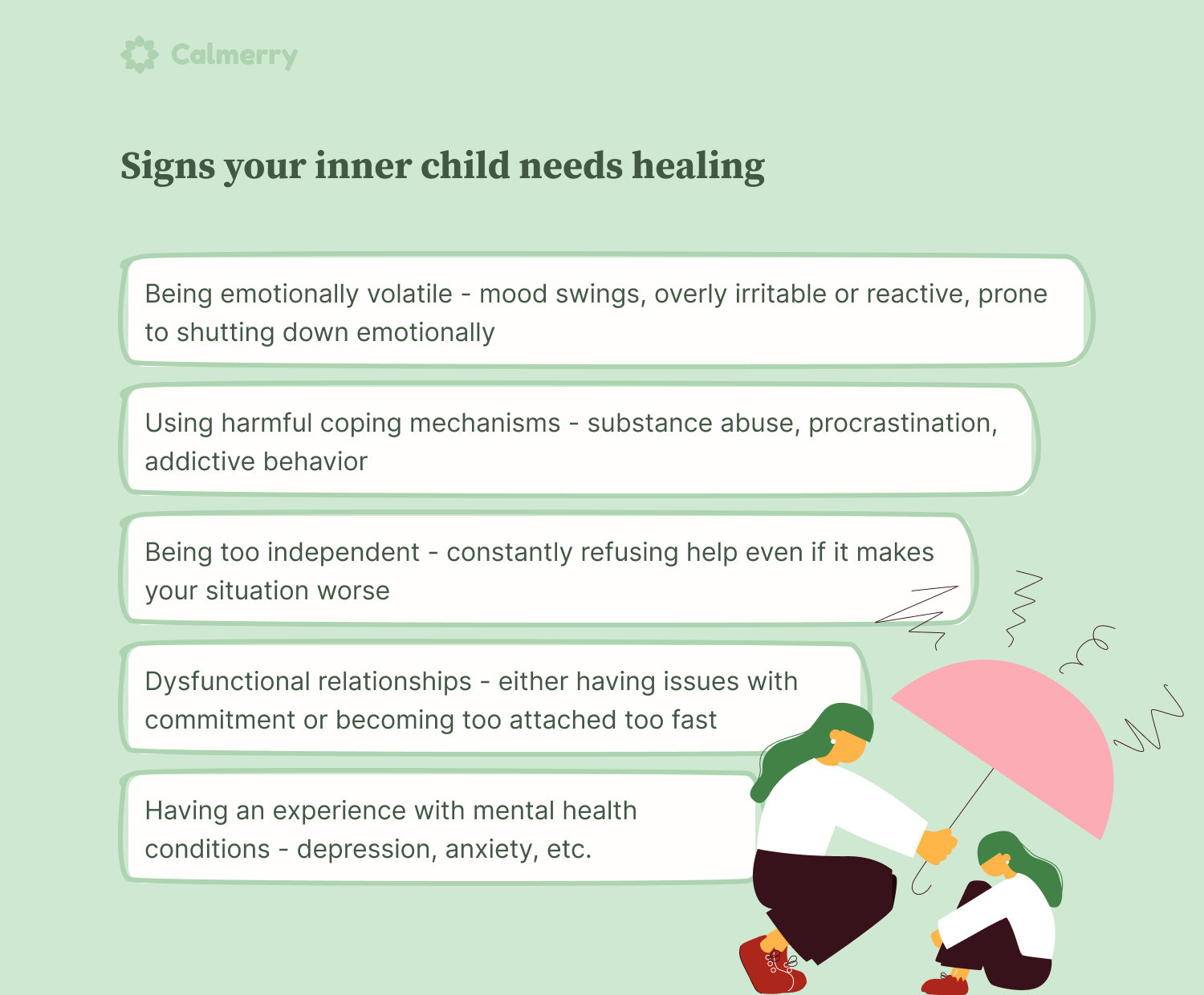
Benefits of finding your inner child
Wounds from our childhood can carry a lot of weight and lead to destructive behaviors that damage ourselves, our relationships, and even the world. These deep-seated wounds can make a person feel incredibly lost, lonely, and hurt throughout their life.
Inner child healing gets us to a place where we truly understand that we’re not bad or unlovable and that our relationships can survive–and even thrive–when we bring our true selves to the table.
In healing our inner child, we get to create the safe and secure experience that our younger selves needed to feel safe enough to heal.
Your inner child also contains wisdom and important life lessons around your personal resilience, how you’ve overcome challenges, and how to replicate positive experiences from your childhood. These include:
- How to build secure relationships
- Ways to tap into your imagination, playfulness, and curiosity
- How to set boundaries
- Recognizing characteristics of your early caregivers you want to adopt vs leave behind
Inner child work
Inner child work, or inner child healing, involves:
- Healing your internal self and building your self-esteem
- Letting go of unhealthy habits, patterns, and relationships
- Learning to take care of, soothe, and regulate yourself (“self-parent”)
- Recognizing and making space for all parts of yourself, including those that you are ashamed of
- Connecting to the adult part of yourself and learning how to make health decisions
We do this by first becoming aware of the wounded child within and developing great compassion for ourselves.
Below are 5 ways to discover, connect with, and heal your inner child.
1. Listen to yourself with compassion
If you’ve ever had a friend or loved one talk with you about self-doubt or a distressing or nerve-wracking experience, and you listened thoughtfully and with compassion, you have the skills to listen to your inner child.
Try speaking to the child within and listening with an open mind. Be prepared for strong emotions to arise, including:
- Abandonment
- Anger
- Anxiety
- Insecurity or rejection
- Shame
- Vulnerability
You might find that when these emotions arise in your adulthood, they connect back to your early experiences. For example, if you find yourself getting angry at your partner for the tiniest things you might link it back to when you were a child and no one paid attention to you, which made you feel angry.
Have compassion for your inner child’s suffering, fear, and shame, just as you would for any friend. Creating space for these feelings helps you to make sense of them and allows you to offer the validation your inner child needs to work through them.
You might find that your inner child bears wounds not just from your life, but from several generations past. Be curious and ready to embrace these wounds in addition to your own.
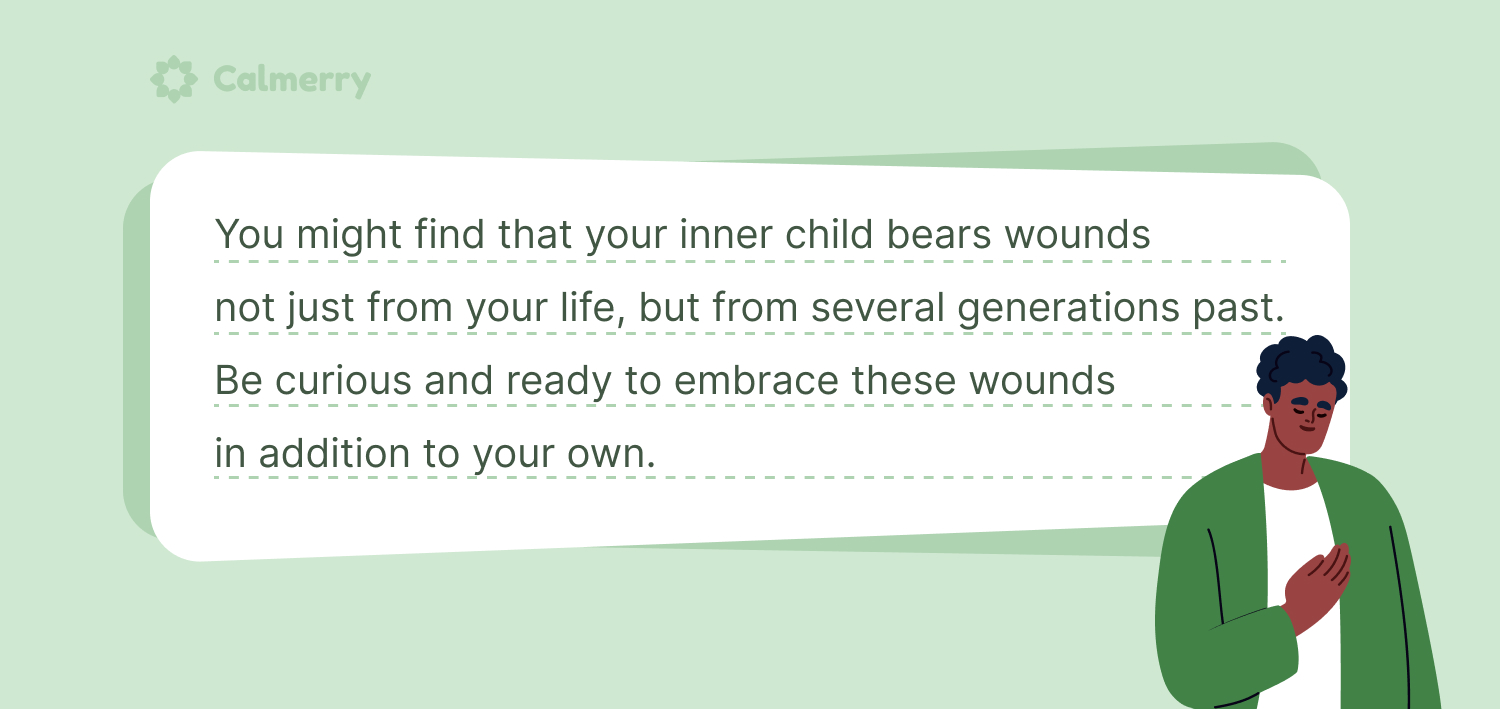
Compassion alone has great healing power and soothes our difficult emotions. If you’ve ever felt like you weren’t acknowledged or truly seen, you have the opportunity to heal that suffering by developing self-compassion and, in turn, expressing it toward the people around you.
It will likely take consistency and time to access your inner child. Try to talk to your child for 10 minutes each day. Speak in child language, rather than adult language. Reassure your child, who has been kept hidden and silent for so long, that you are present and it’s safe to emerge.
2. Practice mindfulness
There are many ways to practice mindfulness, you can be still, you can move, you can be in a quiet, serene place, or you can be in the hustle and bustle of a busy grocery store.
Connect to your breath, scan your body from head to fingertip to toe, or check in with all five of your senses (seeing, hearing, feeling, smelling, tasting).
Mindfulness can boost your self-awareness and allow you to recognize your emotions as they arrive in your daily life. It also helps you manage and cope with your difficult feelings while allowing them to be expressed rather than pushing them down or fighting them.
This validates your inner child’s experience and helps you internalize the idea that you are allowed to have and express any emotions that arise.
3. Engage in creative activities
Playfulness is essential to good emotional health. Take better care of yourself by connecting with your inner child through the things that you loved to do as a kid–particularly activities that engage your creative side. You might color, draw, explore nature, play a game, build something, or start a collection.
Try to visualize your experience as a child. You can do this by sharing stories with your family or childhood friends or even looking at photos, diaries, or art from when you were young. If you don’t have access to any of that stuff, use your imagination.
If you’re lacking many positive childhood experiences to draw from, tap into your playful side and let your inner child have some lighthearted fun. It’s not too late. Do things just for fun–as a child would–and enjoy the small pleasures in life, like taking your first sip of coffee in the morning, walking barefoot in the grass, or laughing with your friends.
This not only helps to heal your inner child but allows you to regain childhood feelings of wonder and optimism while living in the present moment.
4. Journal
Writing engages different parts of your brain than talking, which is part of why journaling is such a powerful tool. Through journaling, you can free yourself from the limitations of your current ways of thinking and have a private and open space for you to connect with your inner child.
As you journal, explore how your inner child thinks and feels without editing or filtering. Think of it as a process of getting to know your child as they are. If you’re stuck, try writing a letter to your inner child to offer reassurance and soothing.
You can also free-write about childhood memories and offer insight into situations that may have been hard for you to make sense of back then. You might ask your inner child:
- How do you feel?
- What do you need to feel safe and supported?
- How can I show up for you?
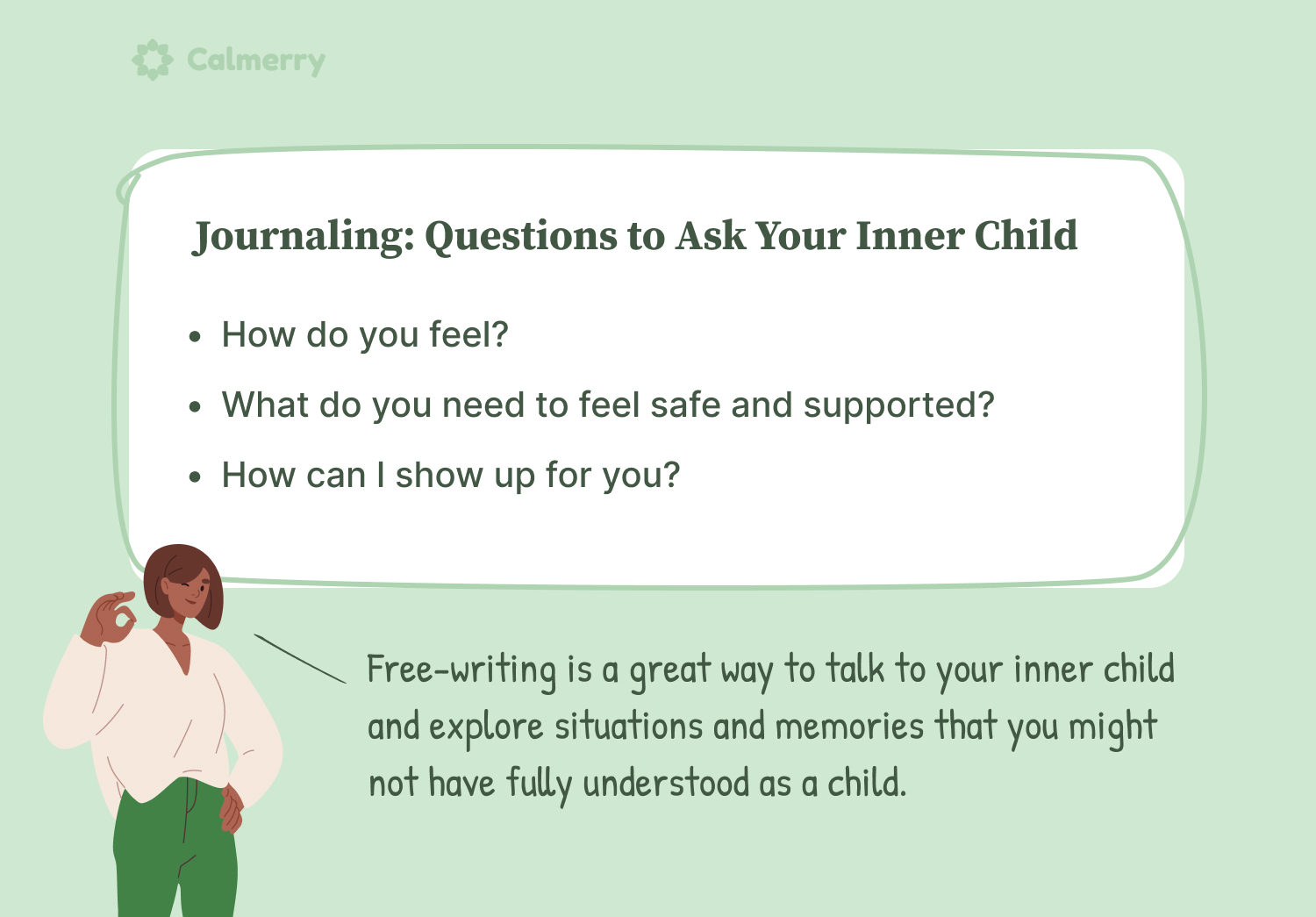
Write from your inner child’s perspective and see what comes up. It can be memories, feelings that you associate with early experiences, or anything else. Don’t let your thoughts get in the way of your writing, but let your inner child’s joy, fear, and pain all emerge.
If you’re nervous or hesitant, that makes complete sense. It can be scary to make room for your inner child’s emotions, particularly when they’ve been buried for so long. Trust that they can do much more damage when they’re repressed and unaddressed and that you, as an adult, have the capacity to soothe and take care of your inner child.
5. Talk to your online therapist
Emotional and psychological safety is a key issue in inner child therapy. Your therapist will work with you to recognize childhood trauma or suffering and compassionately connect with your inner child to develop new ways of managing hurt and pain–whether from childhood abuse, feeling socially isolated or unseen by the people around you, being bullied, or some other challenging experience.
When your inner child exists completely in your unconscious, it will still influence your mind and affect the way you experience life. Your therapist can support you in unearthing repressed emotions, self-regulating, and developing healthy coping strategies.
Through the process of therapy, you can free yourself from the compulsion to act upon the whims of your wounded child and tap into the joy and wonder that you’ve been longing to experience.
online therapy
live video session

